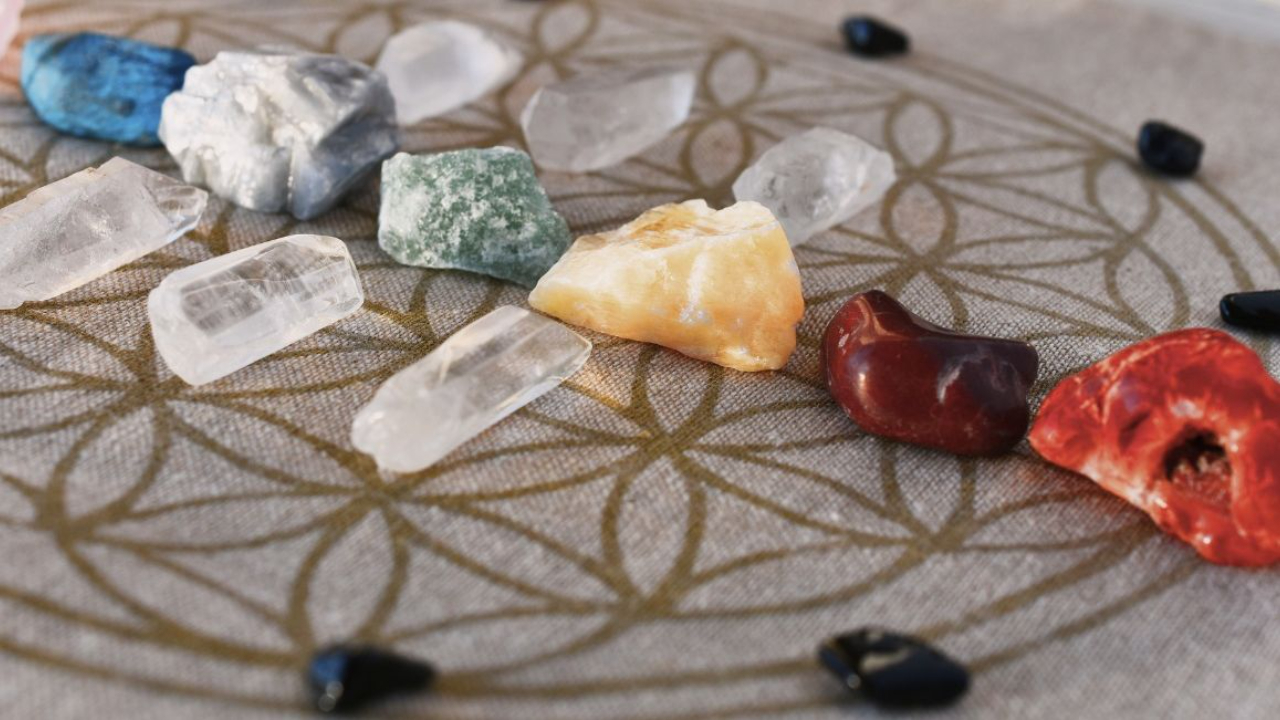Have you ever felt stuck, like no matter what you do, you just can’t seem to move forward? Maybe it’s a recurring issue in your relationships, a sense of lack in your career, or an underlying feeling that something isn’t quite right. I felt stuck in my healing for decades, like I was spinning my wheels, and I couldn’t understand what to do differently. I went to therapy and took medication for my depression and anxiety; I tried Reiki, acupuncture, and massage. You name it, I tried it.
Eventually, I began to realize how trauma had physically changed my biology. This understanding opened the door for me to explore Eastern healing modalities, like chakra balancing, and incorporate them into my journey. For those of us who identify as Wanderers, I believe our naturally sensitive bodies and the unique challenges we bring to Earth can make it harder to achieve radical healing through a single modality alone.
The first time I learned about chakra balancing, it didn’t help much because my body was so severely out of alignment. I think this is important to mention because it’s important to honor your unique body and where you are in your journey. Something that works today may not work tomorrow, and vice versa; that’s the nature of the human healing experience.
With all of this said, I believe that by understanding the neurobiology of chakras, you can truly heal in ways you didn’t know possible before. Chakras are so much more than just mystical concepts; they are potent gateways to understanding our spiritual evolution. The more I dive into the science of the energetic body, the clearer it becomes that chakras have so much power for healing.
To start, I want to share a lesson from The Law of One and the teachings of Ra.
According to The Law of One, each chakra represents a step on our journey toward higher consciousness and spiritual growth. When one of these energy centers becomes imbalanced, it can show up as challenges or blocks in different areas of our lives, holding us back from fully realizing our potential. While this is a simplified way of understanding the chakras, it offers a helpful framework for recognizing how energy imbalances can affect our emotional, physical, and spiritual well-being.

I want this post to be the first in a series that will guide you to a new way to work with your chakras in your spiritual journey. My aim is to help you identify which chakra may be blocked so you can focus on the right tools to overcome your challenges and blockages.
I genuinely believe that by understanding the lessons of each chakra, you can begin to view life’s challenges not as random setbacks but as a purposeful system guiding you toward profound and transformative growth. The insights I share here have been life-changing for me, and my hope is that they can inspire the same transformation in you.
So, let’s dive in and discover how aligning your chakras can guide you back to balance and help you step into the life you’re meant to live.
Basics of the Chakras and Their Role in Spiritual Growth
To understand how chakras relate to our spiritual evolution, we first need to explore what chakras are and why they matter. The word “chakra” comes from Sanskrit and means “wheel” or “disk.” These wheels of energy are spinning centers of spiritual power located along the spine, from the base to the crown of the head. Each chakra governs different aspects of our physical, emotional, and spiritual well-being.
The Seven Major Chakras
There are seven major chakras in the human body, each corresponding to specific areas of life:
- Root Chakra (Muladhara): Located at the base of the spine, this chakra is associated with survival, stability, and a sense of security.
- Sacral Chakra (Svadhisthana): Situated below the navel, it governs creativity, emotions, and relationships with others.
- Solar Plexus Chakra (Manipura): Located in the upper abdomen, this chakra is connected to personal power, confidence, and self-esteem.
- Heart Chakra (Anahata): Positioned in the center of the chest, it’s the bridge between the physical and spiritual, focusing on love, compassion, and connection.
- Throat Chakra (Vishuddha): Found at the throat, this chakra is about communication, self-expression, and speaking one’s truth.
- Third Eye Chakra (Ajna): Located between the eyebrows, it governs intuition, insight, and higher wisdom.
- Crown Chakra (Sahasrara): Positioned at the top of the head, this chakra is linked to spiritual connection, enlightenment, and unity with the universe.
Chakras and Spiritual Evolution
Most people don’t know that the chakras are not just energy centers; they represent different stages of our spiritual evolution. Each chakra embodies specific lessons we must learn as we progress toward enlightenment and self-realization. As we grow, we move through these chakras, starting with the Root Chakra and ascending to the Crown Chakra, each step bringing us closer to a higher state of consciousness.
There’s a misconception that your chakras are always activated and in varying degrees of balance or imbalance.
In reality, chakras are dynamic energy centers that fluctuate depending on your emotional, mental, and spiritual state. They aren’t always fully activated; instead, they can be more or less open, depending on where you are in your personal growth and your challenges.
For example, when focused on survival and basic needs, we primarily operate from the Root Chakra. As we explore our emotions and creativity, we move into the Sacral Chakra. With each stage, the lessons become more complex and spiritually oriented, eventually leading us to the Crown Chakra, where we experience a sense of oneness with all life.
The Chakra System as a Roadmap
Think of the chakra system as a roadmap for spiritual growth. Each chakra represents a milestone on this journey, helping us understand where we are and what we must work on to progress. When one chakra is blocked or out of balance, it can create challenges in the areas of life it governs, signaling that there is work to be done at that level of consciousness.
Understanding Ourselves Through the Chakras
Each chakra corresponds to different aspects of our life, from our basic survival instincts (Root Chakra) to our highest spiritual aspirations (Crown Chakra). When a chakra is balanced, it allows energy to flow freely, contributing to a sense of well-being and harmony in that area of life. However, when a chakra is blocked or overactive, it can manifest as emotional, physical, or spiritual challenges.

In humans, the lower chakras—Root, Sacral, and Solar Plexus—are the first to become activated and are often the most engaged throughout life. These chakras are deeply tied to our basic human experiences and survival instincts, so they are often the most dominant in our energy system and this planet. For many who are struggling, these chakras are imbalanced due to unresolved trauma and living in a lower level of consciousness.
The Root Chakra is connected to our sense of safety, security, and physical survival. It’s activated when we focus on meeting our fundamental needs, such as food, shelter, and financial stability.
The Sacral Chakra governs our emotions, creativity, and relationships, often becoming activated as we navigate the complexities of human connection and emotional expression.
The Solar Plexus Chakra is related to our sense of self, personal power, and autonomy, guiding us as we establish our identity and assert our will in the world.
These lower chakras are activated because they address our physical existence’s immediate and pressing needs. The challenges and lessons associated with these chakras are part of the common human experience as we grow and engage with the world. So often, people spend their entire lives primarily focused on these lower chakras (subconsciously), striving to feel secure, emotionally balanced, and in control of their lives. It can become far too easy to fall into this human illusion and not realize our true power of higher consciousness.
And as long as we are misaligned and have blockages in these lower chakras it prevents us from fully activating the higher chakras—Throat, Third Eye, and Crown. This misalignment keeps us anchored in survival mode, limiting our ability to explore higher states of consciousness and spiritual awareness.
As a result, it’s entirely possible to remain anchored within the framework of the lower chakras, never accessing the higher ones associated with wisdom, spiritual insight, and a sense of unity with the universe. Aligning and understanding the lower chakras is crucial, as they provide the stability and foundation needed to progress into higher levels of spiritual growth and awareness.
Self-Reflection and Chakra Health
One of the most powerful ways to use the chakras for self-understanding is through self-reflection. This process of introspection helps you connect the dots between your life experiences and the corresponding energy centers, providing a roadmap for healing and growth.
Chakras are crucial to your emotional and physical well-being, serving as energy centers that influence various aspects of your life. When you recognize the direct correlation between the state of your chakras and your overall health, you can gain deeper insights into how your body and mind are interconnected.
For instance, consider the connection between your gut health and feelings of worry or anxiety. The Solar Plexus Chakra, located in the area of your stomach and digestive system, governs personal power, confidence, and self-esteem. When this chakra is out of balance, you may experience physical symptoms like digestive issues and emotional disturbances such as excessive worry or self-doubt.
The information here just scratches the surface of how powerful chakras can be in helping you understand and heal your body and mind. When you dive deeper into the relationship between your chakras and your overall well-being, you begin to see how each energy center governs specific physical and emotional aspects of your life and reflects the more profound spiritual lessons you are meant to learn.
Exploring Neurobiology and Your Chakras
Each chakra plays a vital role in your overall well-being, and by exploring them one by one, you can unlock a deeper connection to yourself and your spiritual growth. If you’re ready to continue this exploration, click the link below to explore individual chakras.
- Root Chakra (Muladhara): survival, stability, and a sense of security.
- Sacral Chakra (Svadhisthana): creativity, emotions, and our relationships with others.
- Solar Plexus Chakra (Manipura): personal power, confidence, and self-esteem.
- Heart Chakra (Anahata): bridge between the physical and spiritual, focusing on love, compassion, and connection.
- Throat Chakra (Vishuddha): communication, self-expression, and speaking one’s truth.
- Third Eye Chakra (Ajna): intuition, insight, and higher wisdom.
- Crown Chakra (Sahasrara): spiritual connection, enlightenment, and unity with the universe.


